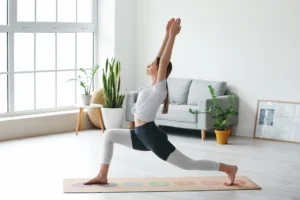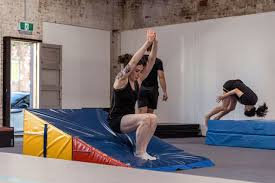Why Do Activities Like Yoga, Ballet, and Gymnastics Require Better Than Normal Flexibility?
Introduction
Flexibility is often seen as a desirable trait for many physical activities. However, in practices like yoga, ballet, and gymnastics, it’s not just desirable – it’s essential. But why is this the case? Let’s delve into the reasons why these activities demand more than the average level of flexibility and how it benefits practitioners.
The Importance of Flexibility in Yoga
Yoga is a holistic practice that connects the body, mind, and spirit through various postures, breathing exercises, and meditation. Flexibility plays a crucial role in yoga for several reasons:

Enhanced Performance
Many yoga poses require a wide range of motion in the joints. Improved flexibility allows practitioners to achieve these poses more easily and with better form. Poses like the “Downward Dog,” “Camel Pose,” and “Wheel Pose” demand a significant amount of flexibility in the hamstrings, spine, and shoulders. Without the necessary flexibility, these poses can be difficult to perform correctly and safely.
Injury Prevention
Flexibility helps in reducing the risk of injuries by ensuring that the muscles and joints can handle the stresses placed on them during practice. When muscles are flexible, they can stretch further without tearing or straining. This is particularly important in yoga, where deep stretching is a common practice. Enhanced flexibility allows for a greater range of motion, reducing the likelihood of injuries such as muscle strains or joint sprains.
Deepening Practice
As flexibility increases, so does the ability to perform more advanced poses, which can deepen the practice and bring more benefits. Advanced yoga poses often require not only flexibility but also strength and balance. For instance, the “King Pigeon Pose” and “Scorpion Pose” require extreme back flexibility and shoulder mobility. With improved flexibility, practitioners can explore these advanced poses, further enhancing their yoga experience and reaping more physical and mental benefits.
Flexibility in Ballet: Grace and Precision
Ballet is a dance form that combines grace, precision, and athleticism. Flexibility is a cornerstone of ballet training for the following reasons:

Range of Motion
Ballet dancers need to perform movements that require extensive stretching and bending. Flexibility ensures that they can achieve the necessary range of motion without strain. For example, the “arabesque” position requires a high degree of flexibility in the hips, lower back, and legs. Without the necessary flexibility, achieving the perfect line and extension in this position would be impossible.
Aesthetic Appeal
Flexibility contributes to the elegant and fluid movements that are characteristic of ballet. It helps dancers achieve the desired lines and shapes that are visually appealing. Ballet is not just about movement but also about creating beautiful shapes with the body. The flexibility of the dancer allows for elongated lines and graceful poses, which are essential for the aesthetic appeal of ballet performances.
Technical Mastery
Many ballet techniques, such as high kicks and splits, are impossible without a high degree of flexibility. It allows dancers to execute these moves with ease and precision. Technical elements like “grand battement” (high kick) and “développé” (unfolding the leg) require flexibility in the hips and legs to perform correctly. Improved flexibility enables dancers to master these techniques, enhancing their overall performance quality.
Gymnastics: Strength and Flexibility Combined
Gymnastics is a sport that demands both strength and flexibility. Here’s why flexibility is crucial in gymnastics:

Skill Execution
Many gymnastics skills, such as backflips, splits, and handstands, require significant flexibility. It allows gymnasts to perform these skills correctly and safely. Flexibility in gymnastics is essential for achieving the full range of motion needed for various stunts. For instance, performing a split requires flexibility in the hip flexors and hamstrings. Without adequate flexibility, gymnasts would not be able to execute these skills effectively.
Injury Prevention
Flexibility reduces the risk of muscle strains and joint injuries by ensuring that the body can handle the extreme movements required in gymnastics. Gymnastics involves dynamic and often extreme movements that put significant stress on the muscles and joints. Enhanced flexibility helps in distributing this stress more evenly across the body, reducing the risk of injuries.
Performance Quality
Higher flexibility can improve the overall quality of performance by enabling smoother transitions between movements and more impressive stunts. Flexibility allows gymnasts to perform complex routines with fluidity and grace. For example, transitioning from a “handstand” to a “split” requires seamless flexibility and control. Improved flexibility enhances the aesthetic appeal and technical precision of gymnastics performances.
Benefits of Better Than Normal Flexibility
Achieving better than normal flexibility has numerous benefits, particularly for those engaged in yoga, ballet, and gymnastics:
Improved Circulation
Stretching and flexibility exercises enhance blood flow to the muscles, promoting better circulation and overall health. Improved circulation helps in delivering more oxygen and nutrients to the muscles, promoting faster recovery and reducing muscle soreness.
Enhanced Muscle Coordination
Flexibility training improves muscle coordination and balance, which is essential for executing complex movements in these activities. Enhanced muscle coordination ensures that different muscle groups work together efficiently, improving overall performance and reducing the risk of injuries.
Reduced Muscle Soreness
Regular flexibility exercises can help reduce muscle soreness and stiffness, promoting quicker recovery after intense workouts. Stretching helps in breaking down lactic acid build-up in the muscles, reducing muscle soreness and promoting faster recovery.
How to Improve Flexibility
Improving flexibility is a gradual process that requires consistent effort. Here are some tips to enhance your flexibility:
Regular Stretching
Incorporate stretching exercises into your daily routine. Focus on major muscle groups and hold each stretch for at least 30 seconds. Consistent stretching helps in gradually improving flexibility and maintaining it over time.
Yoga and Pilates
Practicing yoga or Pilates can significantly improve your flexibility while also strengthening your muscles. These practices involve a variety of stretching exercises that target different muscle groups, promoting overall flexibility and strength.
Dynamic Warm-Ups
Before engaging in any physical activity, perform dynamic warm-up exercises to prepare your muscles and joints for the workout. Dynamic warm-ups, such as leg swings and arm circles, help in increasing blood flow to the muscles and improving flexibility.
Stay Hydrated
Proper hydration is essential for maintaining the elasticity of your muscles and tissues. Drinking enough water helps in keeping your muscles and joints lubricated, promoting better flexibility and reducing the risk of injuries.
The Science Behind Flexibility
Flexibility is influenced by several factors, including muscle elasticity, joint structure, and nervous system function. Understanding the science behind flexibility can help in optimizing your flexibility training.
Muscle Elasticity
Muscles are made up of fibers that can stretch and contract. The elasticity of these fibers determines the range of motion of the muscle. Regular stretching helps in maintaining and improving muscle elasticity, promoting better flexibility.
Joint Structure
The structure of your joints also influences your flexibility. Some joints, like the shoulder joint, have a wider range of motion compared to others, like the knee joint. Understanding the structure of your joints can help in targeting your flexibility training effectively.
Nervous System Function
The nervous system plays a crucial role in flexibility by controlling the length and tension of your muscles. Stretching exercises help in training the nervous system to allow for a greater range of motion, improving flexibility.
Common Flexibility Myths
There are several myths surrounding flexibility that can hinder your flexibility training. Here are some common myths debunked:
Myth 1: Flexibility is Only Important for Athletes
Flexibility is important for everyone, not just athletes. Improved flexibility can enhance your overall physical health, reduce the risk of injuries, and improve your quality of life.
Myth 2: Stretching is the Only Way to Improve Flexibility
While stretching is an important part of flexibility training, other activities like yoga, Pilates, and dynamic warm-ups can also help in improving flexibility. Incorporating a variety of flexibility exercises into your routine can promote better flexibility.
Myth 3: You Need to Stretch for Long Periods to Improve Flexibility
Consistency is more important than the duration of stretching. Short, regular stretching sessions can be more effective in improving flexibility than occasional long sessions.
Flexibility Training for Different Age Groups
Flexibility training can benefit people of all ages. Here are some tips for flexibility training for different age groups:
Children and Adolescents
Flexibility training for children and adolescents should focus on fun and engaging activities. Incorporating activities like yoga and dance into their routine can help in improving flexibility while also promoting physical activity.
Adults
Flexibility training for adults should focus on maintaining and improving flexibility through regular stretching exercises. Incorporating activities like yoga and Pilates into your routine can help in promoting overall flexibility and physical health.
Older Adults
Flexibility training for older adults should focus on gentle stretching exercises to maintain flexibility and reduce the risk of injuries. Activities like chair yoga and gentle stretching exercises can help in promoting flexibility and overall physical health.
Flexibility Training for Different Skill Levels
Flexibility training should be tailored to your skill level. Here are some tips for flexibility training for different skill levels:
Beginners
Beginners should focus on basic stretching exercises and gradually increase the intensity and duration of their flexibility training. Consistency is key in improving flexibility, so it’s important to incorporate regular stretching into your routine.
Intermediate
Intermediate practitioners should focus on more advanced stretching exercises and incorporate activities like yoga and Pilates into their routine. It’s important to listen to your body and avoid pushing yourself too hard to prevent injuries.
Advanced
Advanced practitioners should focus on maintaining and improving flexibility through a variety of stretching exercises and activities like yoga and Pilates. It’s important to incorporate regular flexibility training into your routine and listen to your body to avoid injuries.
Conclusion
Flexibility is a vital component of yoga, ballet, and gymnastics, contributing to enhanced performance, injury prevention, and overall body health. By understanding the importance of flexibility and incorporating regular stretching and flexibility exercises into your routine, you can enjoy the many benefits it brings to these activities and beyond.
For more detailed information and resources on improving flexibility, you can check out these articles:
- Yoga Journal: Flexibility in Yoga
- Dance Magazine: The Importance of Flexibility in Ballet
- USA Gymnastics: Flexibility in Gymnastics
Stay committed to your flexibility journey and enjoy the remarkable improvements in your practice and performance!
